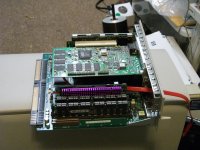I received my two L2/G3 upgrades today. Although listed as Used, they look new or unused. The antistatic bags are sealed. The innards are shrink wrapped. This could just be good repackaging, but it could also be that the seller happened on some unsold stock.
I took the heat sinks off. The PPC750s on the cards have '350' on them, implying that they are actually rated for 350MHz rather than 400MHz. The stickers and everything else say these are 400MHz cards.
I recall that there was a todo several years back about Sonnet selling upgrades make with CPUs which were rated slower than the upgrade. Sonnet said that the chips were actually rated for the higher speed. Consumers complained. Given the relationship between speed and temperature ratings, it is possible that Sonnet was telling the truth. But I think they gave up the practice.
These could be unsold stock left over from that debacle.
I have not actually stuck them in a computer yet to test their operation. I like to let my Ebay purchases sit around unused (or even unopened) for months, so when/if there is a problem I have no recourse.

The L2 cache chips are Micron MT58L64L32P - 7.5A chips which are listed as 113MHz on the datasheet and 8.8ns cycle time but 7.5ns access time.
Now I just can't make heads or tails of this. I thought I read that the cache on these things ran at 1/2 the CPU speed. That would be 200MHz. But even if it was 1/3, it should still need 133MHz cache RAM.
Still more confusing, IBM's datasheet lists L2 clock ratios (to CPU core clock) of 1/1, 1/1.5, 1/2, 1/2.5 and 1/3. So 1/3 is the slowest L2 clock ratio. 1/1 is the fastest. Yet, IBM also lists 250MHz as the fastest supported L2Clock speed on a datasheet for a CPU which runs at least up to 500MHz. I guess they could mean that those L2 clock ratios are supported, but don't run the L2 clock faster than 250MHz.
Okay, so taking that interpretation, and adding tha tthe IBM datasheet shows "L2 Cycle Time" as a simple recipricole of the clock speed, that would mean that 8.8ns cycle time and 113MHz do go together.
So, I think this SRAM is a little underrated for the speed it probably runs at. On the other hand, that 'P' suffic on the part number has me wondering. I have only been able to find a datasheet for the 'F' suffix, and that is listed as commercial temperature range. I wonder if the P might be industrial or military. A wider temperature range will usually run fine at higher speeds in a narrow temperature range environment.
I have 48 Galvantech 128K X 32 SRAM chips on hand, but they're rated for 10ns cycle time/100 MHz operation. Even slower (though not by much) than the Micron chips on the board. However, they are twice the capacity and they are rated for Industrial temperatures, rather than commerical.
Digikey has some nice Cypress CY7C1347, 128K X 32 chips rated for 250MHz for $11+ each. I may pick up a few of those and try them.

